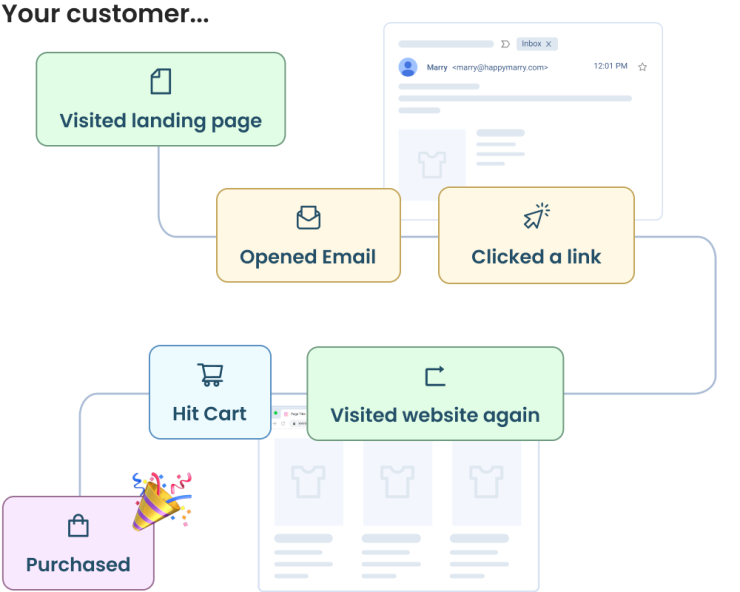Delivering an exceptional customer experience is no longer just a nice-to-have, but a critical differentiator for businesses.
Companies that prioritize understanding their customers’ journeys are well-positioned to create seamless, personalized experiences that foster loyalty and drive growth.
Enter customer journey tracking – a powerful tool that unveils the intricate paths your customers take, enabling you to identify pain points, optimize touchpoints, and craft experiences that truly resonate with your audience.
Demystifying Customer Journey Tracking
At its core, customer journey tracking involves mapping the various interactions and touchpoints a customer has with your brand, from the initial awareness stage to post-purchase engagement and beyond.
This holistic view provides invaluable insights into how customers navigate your products or services, their preferences, and the challenges they encounter along the way.
By leveraging advanced analytics and data-driven techniques, you can gain a comprehensive understanding of your customers’ behavior, motivations, and expectations.
This knowledge empowers you to make informed decisions that enhance the overall customer experience, ultimately driving increased satisfaction, retention, and revenue.
Mapping the Customer Journey
The customer journey begins with awareness, where potential customers first learn about your brand.
Tracking their initial interactions, such as website visits, social media engagement, or ad clicks, can help you optimize your marketing efforts and ensure a seamless introduction to your offerings.
As customers progress to the consideration stage, tracking their research activities, product comparisons, and interactions with your sales team becomes crucial. This insight allows you to address their specific concerns, provide relevant information, and guide them towards a well-informed purchase decision.
The purchase phase is a pivotal moment in the customer journey, and tracking the seamlessness of the transaction process, from checkout to delivery, can reveal areas for improvement. Identifying and addressing any friction points in this stage can significantly enhance the overall experience and increase conversion rates.
Beyond the Purchase: Nurturing Long-Lasting Relationships
However, the customer journey doesn’t end at the purchase; it’s an ongoing cycle that requires nurturing to foster long-lasting relationships.
By tracking post-purchase interactions, such as product usage, support inquiries, and feedback, you can proactively address any concerns, offer personalized recommendations, and create opportunities for upselling or cross-selling.
This continuous engagement not only strengthens customer loyalty but also provides valuable insights for product development and service improvements.
Implementing a Customer Journey Tracking Strategy
Implementing a customer journey tracking strategy involves leveraging various tools and technologies.
Website analytics, heatmapping, session recordings, and customer feedback platforms can provide valuable data points to map the customer journey accurately.

Additionally, integrating customer relationship management (CRM) systems and leveraging artificial intelligence (AI) and machine learning can help automate and streamline the data collection and analysis processes, enabling you to make data-driven decisions in real-time.
However, it’s crucial to remember that customer journey tracking is not a one-size-fits-all approach. Every business is unique, and tailoring the strategy to your specific industry, target audience, and business objectives is essential for maximizing its impact.
Regularly reviewing and refining your approach based on customer feedback and market trends is also vital to ensure its continued effectiveness.
Key Takeaways
- Embrace customer journey tracking as a powerful tool to gain a comprehensive understanding of your customers’ experiences, preferences, and pain points across all touchpoints.
- Leverage data-driven insights to optimize touchpoints, address friction points, and deliver personalized, seamless experiences that drive customer satisfaction and loyalty.
- Nurture long-lasting relationships by tracking post-purchase interactions and proactively addressing concerns, offering recommendations, and creating opportunities for upselling or cross-selling.
- Implement a tailored customer journey tracking strategy that aligns with your business objectives, leveraging the right tools and technologies to streamline data collection and analysis.
- Continuously refine and optimize your customer journey tracking approach to stay ahead of evolving customer expectations and market dynamics, ensuring its ongoing relevance and effectiveness.
Businesses that prioritize understanding and optimizing the customer journey will have a significant competitive advantage.
By embracing customer journey tracking, you can unlock invaluable insights, create exceptional experiences, and foster long-lasting, meaningful relationships with your customers – the key to sustainable success in the modern business world.
FAQs:
- Why is customer journey tracking important for businesses?
Customer journey tracking provides valuable insights into customer behavior, preferences, and pain points, enabling businesses to optimize touchpoints, deliver personalized experiences, and drive customer satisfaction and loyalty. -
How does customer journey tracking help improve customer experiences?
By understanding the customer journey, businesses can identify and address friction points, provide relevant information at each stage, and craft seamless, personalized experiences that resonate with customers. -
What tools and technologies are used for customer journey tracking?
Common tools include website analytics, heatmapping, session recordings, customer feedback platforms, CRM systems, and AI/machine learning for data collection and analysis. -
How can businesses track the post-purchase customer journey?
Tracking post-purchase interactions, such as product usage, support inquiries, and feedback, allows businesses to proactively address concerns, offer personalized recommendations, and create opportunities for upselling or cross-selling. -
What are the key stages of the customer journey?
The main stages include awareness, consideration, purchase, and post-purchase engagement, each with its own set of touchpoints and interactions to track. -
How can businesses tailor their customer journey tracking strategy?
Tailoring the strategy to the specific industry, target audience, and business objectives is essential for maximizing the impact of customer journey tracking. -
What are the benefits of customer journey tracking for marketing efforts?
Customer journey tracking can help optimize marketing efforts by providing insights into how customers first learn about a brand, their research activities, and their engagement with marketing campaigns. -
How does customer journey tracking contribute to sales and conversion rates?
By understanding the customer journey during the consideration and purchase stages, businesses can address specific concerns, provide relevant information, and streamline the transaction process, ultimately increasing conversion rates. -
How can businesses leverage customer journey tracking for long-term customer relationships?
Tracking post-purchase interactions and proactively addressing concerns, offering recommendations, and creating opportunities for upselling or cross-selling can foster long-lasting, meaningful relationships with customers.
